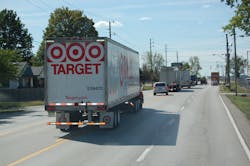Brian Gibson, a professor of supply chain management and executive director of the center for supply chain innovations at Auburn University, believes “speed to market” is becoming a more critical metric for retailers in the U.S. – and as a result they are placing more importance on supply chain services going forward.
He recently shared his findings from two-dozen interviews with senior executives at a wide variety of retail companies in a conference call hosted by Stifel Financial Corp.
“It’s about how do we get the order to the right node of the supply chain? [For] the right node isn’t always necessarily the one that’s closest to the customer,” Gibson explained. “A lot of retailers are getting smarter and saying it’s not just about transportation cost optimization over speed, they’re looking at a multitude of factors. It’s a ‘save the sale’ issue [and a] split shipment concept [restocking store inventory and fulfilling online orders simultaneously] they’re trying to deal with.”
He noted that in a couple of the interviews with so-called “high end” and “fashion oriented” retailers, senior executives explained it’s not just important that that they have the right priced product in stock at the stores but the speed of getting those products to market.
The reason they have to “get it to market” faster, Gibson emphasized is many feel that “customers are far less loyal today than they were in the past; therefore how effectively your supply chain can fulfill demand becomes a competitive differentiator as opposed to that loyalty. It’s an interesting shift away from ‘marketing and sales’ orientation to a ‘supply chain’ orientation for some of these retailers.”
Jess Dankert, senior director of retail operations for the Retail Industry Leaders Association (RILA), added that because retailers are also dealing with ever-thinner margins that are “really taking a hard look” at the current transportation assets they have in place.“Whereas in the past you might be upgrading a distribution center [DC] to have the latest and greatest of material handling equipment, that’s not really ‘feeding out’ to the end-benefit of the customer,” she explained. “So the [supply chain] improvements you’re seeing now are really focusing on that end goal of servicing the customer. To that end I think that because the supply chain is becoming more customer-focused; it’s being seen as much more of a strategic advantage. Because of that there’s a lot more access to investment funds for the supply chain to improve those things as long as they’re making smart choices and picking the smart growth options.”
What does mean for trucking and other logistics providers to the retail sector? Dankert said that instead of being “responsive and responding to” customer demands, the focus is now about “being anticipatory” by “seeing ahead” and “meeting needs” before they necessarily even exist.
“This is a whole other level kind of [supply chain] planning that needs to be put in place, along with an understanding of the customer,” she explained. “In a lot of cases that need for integration is really driven by omni-channel demand. One key aspect of the omni-channel is that idea of breaking down the silos across the organization; about [creating an] end-to-end concept in terms of the integration with merchandising folks and the buying procurement folks, the stores, the supply chain and integrating all those together.”
Dankert added that the retail industry is “getting to a point” where that actually needs to happen.
“We’re really seeing a lot of that kind of migration of bringing that planning aspect under the supply chain, so that you have that integrated approach to it from the end-to-end piece,” she stressed.
“Some have already embedded a supply chain person in the merchant group and some are taking a merchandise planner and putting them in the supply chain group,” Dankert noted. “Some are even moving [sales and marketing] activities, lock, stock and barrel, over to supply chain where they say the merchants decide what we’re going to buy and the supply chain folks start to decide how much and when and where we’re going to stock it. That is the real leading edge.”
About the Author
Sean Kilcarr
Editor in Chief
Sean Kilcarr is a former longtime FleetOwner senior editor who wrote for the publication from 2000 to 2018. He served as editor-in-chief from 2017 to 2018.

